
“Is the iPhone 7 worth upgrading to?”
This is the question I’ve been asked by friends, family and MobileSyrup readers since the somewhat controversial iPhone 7 and iPhone 7 Plus were revealed.
It’s a difficult inquiry to respond to because while, yes, the iPhone 7 is a surprisingly significant upgrade over the 6s in many respects, it’s actually more so than some analysts expected: it’s water resistant, more powerful, sleeker and, as predicted, the tech giant has also killed the 3.5mm headphone jack.
Depending on your expectations, however, these upgrades might not be enough for you. Make no mistake, this is not a radical redesign of the iPhone 6s and 6s Plus.
Similar to the jump between Samsung’s Galaxy S6 and the S7, the iPhone 7 is an incremental upgrade that solves most, but not all of the issues many people had with the iPhone 6s.
Now that both high-end Android phones and the iPhone have reached the age of maturity, game-changing features are poised to become more of a rarity. Welcome to the new era of iterative smartphone upgrades.
Specs
- iOS 10
- A10 Fusion chip with 64-bit architecture
- 2GB of RAM (iPhone 7) 3GB of RAM (iPhone 7 Plus)
- Capacity: 32GB, 128GB, 256GB
- 12 megapixel sensor, Optical Image Stabilizer, f/1.8, 4K video recording at 30 fps
- FaceTime HD Camera: 7 megapixel, 1080p HD video recording
- Colours: Rose Gold, Gold, Silver, Black, Jet Black
- 138.3 mm x 67.1 mm x 7.1 mm (iPhone 7) 158.2 x 77.9 x 7.3mm (iPhone 7 Plus)
- Dual stereo speakers, Lightning connector
- Fingerprint sensor built into the new ‘Taptic Engine’ Home Button
- 4.7-inch retina HD display, 334 x 750 pixel resolution at 326 ppi (iPhone 7) 5.5-inch 1080 x 1920 pixel IPS dsiplay at 401 ppi (iPhone 7 Plus)
- 1960mAh battery (iPhone 7) 2,900mAh (iPhone 7 Plus)
- Rated IP67 under IEC standard 60529, water and dust resistant
- Touch ID fingerprint sensor, barometer, three-axis gyro, accelerometer, proximity sensor, ambient light sensor
Death of the 3.5mm headphone jack
 Much of the narrative surrounding the iPhone 7 and 7 Plus revolves around Apple’s decision to kill the headphone jack, a port that for more than a century has provided an easy and ubiquitous way to connect audio devices, in favour of Lightning headphones and a Lightning to 3.5mm adapter that’s included in the box.
Much of the narrative surrounding the iPhone 7 and 7 Plus revolves around Apple’s decision to kill the headphone jack, a port that for more than a century has provided an easy and ubiquitous way to connect audio devices, in favour of Lightning headphones and a Lightning to 3.5mm adapter that’s included in the box.
This shift has been seen by many as a slap in the face to consumers. Apple has a history of nixing aging technology from its devices, with the removal of the optical drive from most versions of its MacBook laptops being the most notable example. This resulted in thinner devices and consumers were able to see a visible tradeoff.
What makes removing the 3.5mm headphone jack from the iPhone 7 and 7 Plus more difficult to swallow, is the benefits from the port being dropped aren’t immediately apparent, which, has spurred conspiracy theorists and notable tech pundits to jump on the “Apple has digital audio DRM doomsday plans” commentary bandwagon.
 Sure, battery life has been improved by two hours with the 7 and one hour with the 7 Plus, the phone now includes stereo speakers — which feature the best sound I’ve heard from a smartphone — but the benefits of dropping the jack aren’t immediately obvious and will likely be lost on the average consumer.
Sure, battery life has been improved by two hours with the 7 and one hour with the 7 Plus, the phone now includes stereo speakers — which feature the best sound I’ve heard from a smartphone — but the benefits of dropping the jack aren’t immediately obvious and will likely be lost on the average consumer.
On the other hand, Apple also claims removing the headphone jack helped the company achieve IP67 water resistance certification for the device, which is likely true. However, both the Note 7 — which has recently been recalled — and the S7 and S7 Edge, arguably the iPhone’s main competitors in the high-end handset space, feature 3.5mm headphone jacks and are also IP68 waterproof, allowing the phones to be submerged in 1.5 meters of water for 30 minutes.
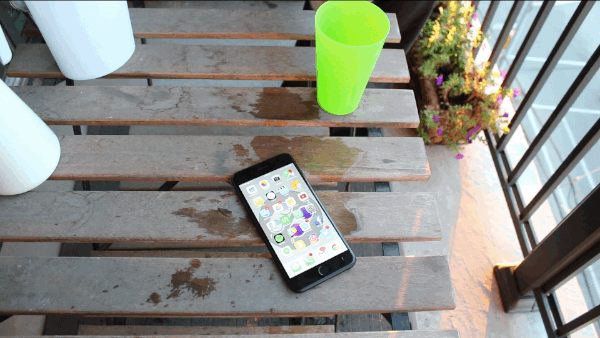 In comparison, the iPhone 7’s IP67 certification means the device can only be submerged one meter for 30 minutes. To the average user, the difference between the two competing devices’ water resistant certification means very little, though it’s interesting Samsung was able to achieve IP68 without removing the headphone jack.
In comparison, the iPhone 7’s IP67 certification means the device can only be submerged one meter for 30 minutes. To the average user, the difference between the two competing devices’ water resistant certification means very little, though it’s interesting Samsung was able to achieve IP68 without removing the headphone jack.
Realistically, dropping the jack changes very little. If you’re an EarPod user, just use the lightning headphones included in the box. If you happen to own an expensive 3.5mm headset, leave them plugged into the included adapter and you’re good to go.
 Of course, there are also Apple’s AirPod headphones, which unlike many people, I’m actually quite fond of, though their $230 CAD price tag is rather steep (we’ll be doing a separate story on Apple’s AirPods in the coming days). Of course, Apple’s headphones can no longer be used with other devices and for some, this could be a significant drawback.
Of course, there are also Apple’s AirPod headphones, which unlike many people, I’m actually quite fond of, though their $230 CAD price tag is rather steep (we’ll be doing a separate story on Apple’s AirPods in the coming days). Of course, Apple’s headphones can no longer be used with other devices and for some, this could be a significant drawback.
Where Apple truly falters with the removal of the jack is the fact that the iPhone 7 and iPhone 7 Plus remain the same thickness as the iPhone 6s and 6s Plus, 7.1mm and 7.3mm respectively. Motorola dropped the 3.5mm in the Moto Z in favour of USB-C, resulting in the thinnest smartphone of all time.
It would have been great if Apple made a similar size reduction with the 7 and 7 Plus, though the company is likely saving that move for the inevitable iPhone 8. It would have been great if Apple adopted USB-C rather than lightning for the iPhone 7, allowing the company to use the cross-platform standard, but given the Cupertino tech giant’s penchant for proprietary adapters, there’s no way that was ever going to happen.
 For many, despite the rampant controversy surrounding the headphone jack being dropped, it’s really not that huge of an issue and while Phil Schiller, Apple’s senior vice president of worldwide marketing, saying that killing the headphone jack took “courage,” has transformed into an admittedly amusing running joke in the tech industry, sometimes aging technology really does need to be killed in order to push the industry forward.
For many, despite the rampant controversy surrounding the headphone jack being dropped, it’s really not that huge of an issue and while Phil Schiller, Apple’s senior vice president of worldwide marketing, saying that killing the headphone jack took “courage,” has transformed into an admittedly amusing running joke in the tech industry, sometimes aging technology really does need to be killed in order to push the industry forward.
It’s just unfortunately not clear yet where the tech industry is headed in this particular space.
3GS throwback
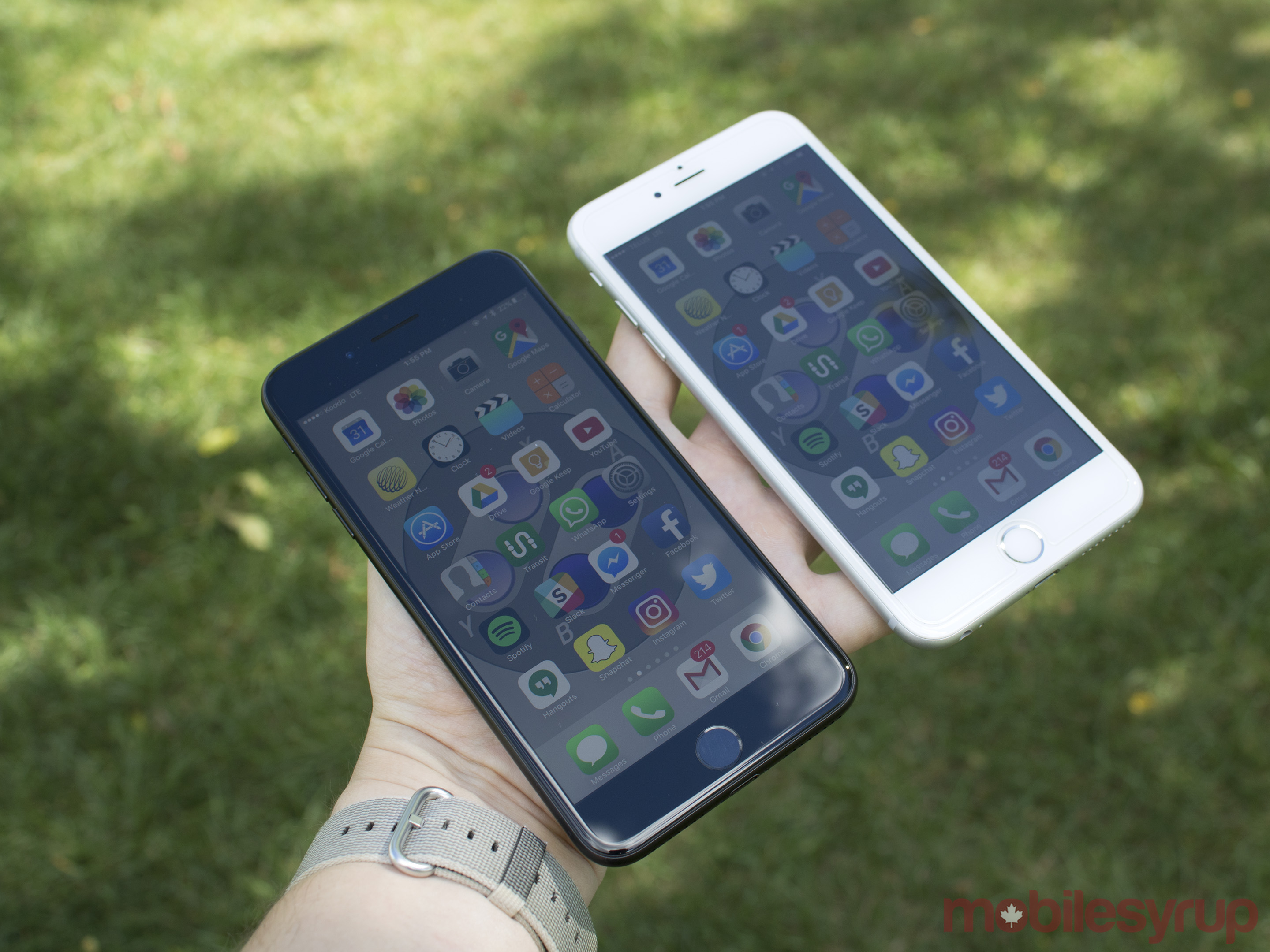 While Apple isn’t keen to admit it, the iPhone 7’s sleek new jet black colour looks like a throwback to the classic iPhone 3GS, which, as you might have expected, turns the phone into a smudge, grease and fingerprint magnet. While it hasn’t happened yet, I also predict the jet black iPhone 7 is a scratch magnet — Apple has already amusingly suggested consumers put the phone in a case. I far prefer the new matte black colour option over Jet Black, though it shows grease stains as well. The iPhone 7 and 7 Plus is also available in rose gold, gold and silver, with my personal favourite colour, space grey, being unfortunately jettisoned into the atmosphere this year.
While Apple isn’t keen to admit it, the iPhone 7’s sleek new jet black colour looks like a throwback to the classic iPhone 3GS, which, as you might have expected, turns the phone into a smudge, grease and fingerprint magnet. While it hasn’t happened yet, I also predict the jet black iPhone 7 is a scratch magnet — Apple has already amusingly suggested consumers put the phone in a case. I far prefer the new matte black colour option over Jet Black, though it shows grease stains as well. The iPhone 7 and 7 Plus is also available in rose gold, gold and silver, with my personal favourite colour, space grey, being unfortunately jettisoned into the atmosphere this year.
Overall, the phone’s form factor is the same as it has been for the last few generations of the iPhone, though it does feature a few subtle differences.
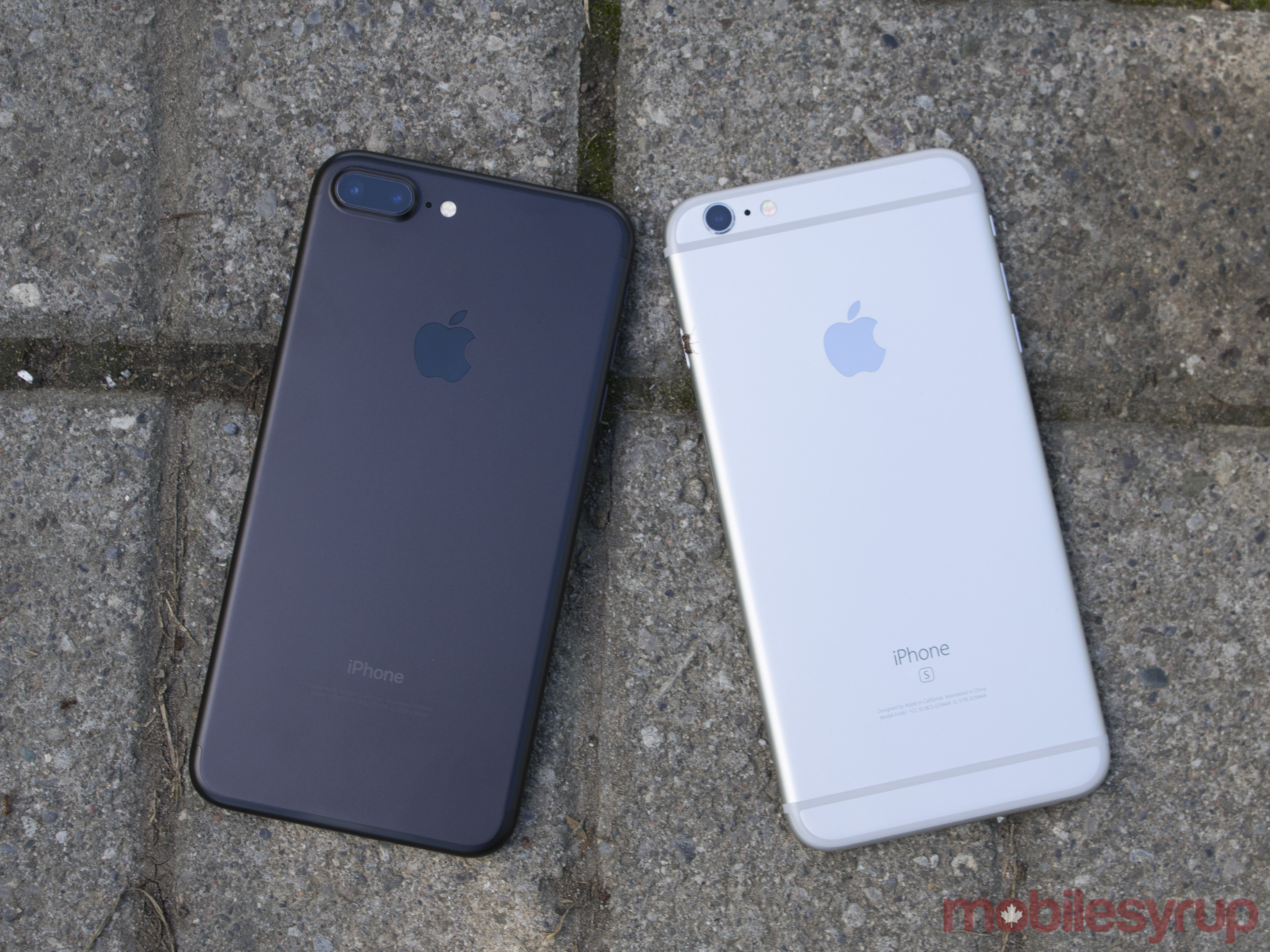 The first thing most people will notice about the 7, apart from the 3.5mm headphone jack’s absence, is its new ‘Taptic Engine’ home button. Similar to the 2015 and 2016 MacBook, rather than a physical button, the iPhone 7’s Home Button subtly vibrates, with three distinct levels of intensity that can be altered in the settings.
The first thing most people will notice about the 7, apart from the 3.5mm headphone jack’s absence, is its new ‘Taptic Engine’ home button. Similar to the 2015 and 2016 MacBook, rather than a physical button, the iPhone 7’s Home Button subtly vibrates, with three distinct levels of intensity that can be altered in the settings.
At first, as I discussed in my hands-on, I loathed the Taptic Engine because it makes the entire base of the phone feel like it’s vibrating, similar to the haptic feedback featured in some Android phones but considerably more intense. However, over the course of the last few days, it’s grown on me considerably, especially when playing games and using apps that take advantage of the feature. Unlike traditional haptic feedback, Apple’s Taptic Engine more closely resembles the feel of touching physical buttons, a sensation I’ve never experienced before with a touchscreen.
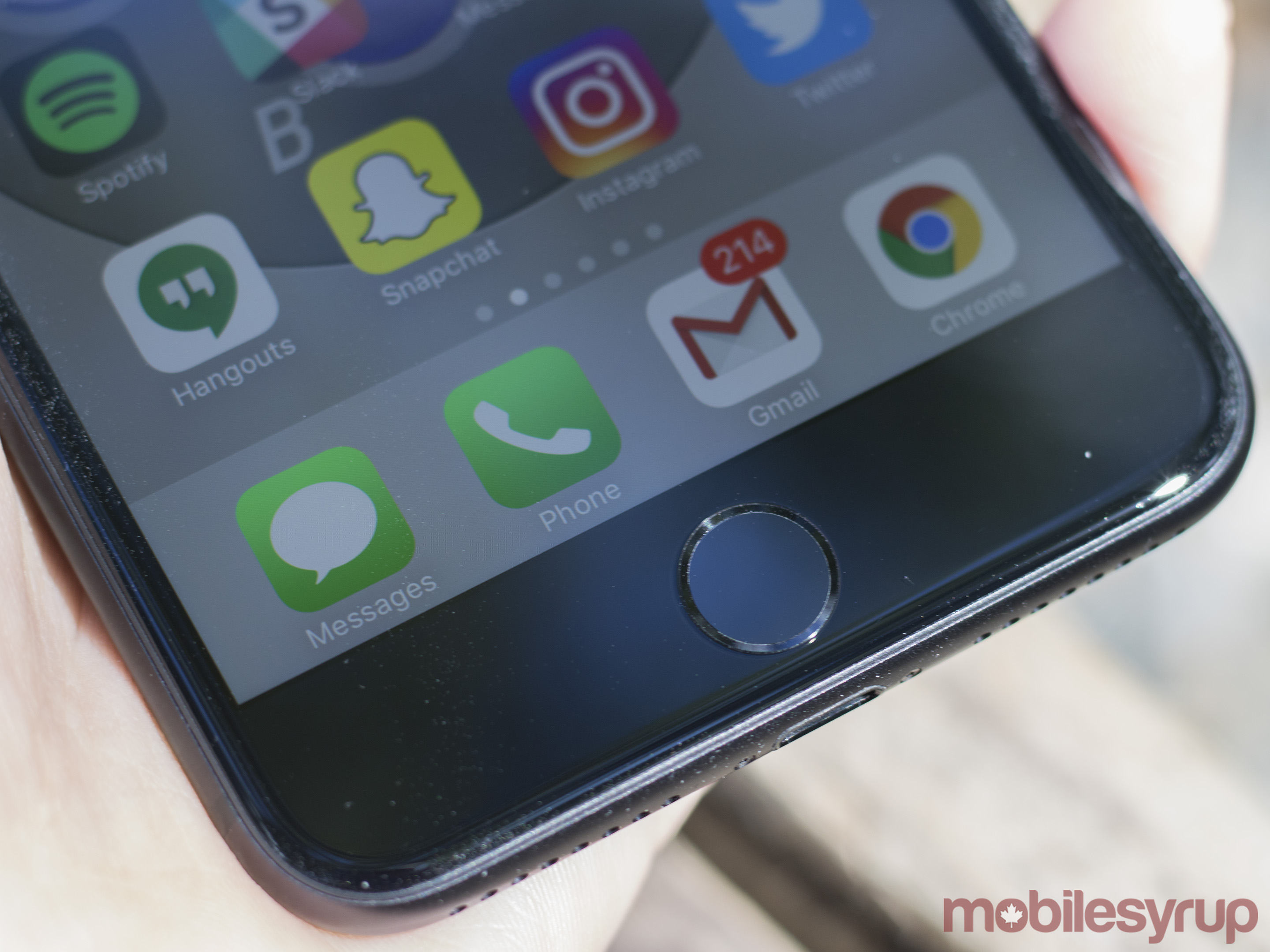 Build-wise, apart from the the headphone jack removal I discussed earlier, and cleverly hiding the 7’s antenna lines in the top and bottom of the phone, Apple’s latest iPhone, especially when looking at any colour variant that isn’t Black or Jet Black, looks nearly identical to the 6s.
Build-wise, apart from the the headphone jack removal I discussed earlier, and cleverly hiding the 7’s antenna lines in the top and bottom of the phone, Apple’s latest iPhone, especially when looking at any colour variant that isn’t Black or Jet Black, looks nearly identical to the 6s.
It’s worth mentioning, however, that the camera bump now has a curve to it, with the phone’s body slanting into the shooter, as opposed to it sticking out a few millimeters like it did with iPhone 6s. While at first I wasn’t fond of this aesthetic shift, it quickly grew one me and gives the rear of the 7 a new, rounded look.
For me, one of the main issues surrounding the 7’s reveal is whether or not it stands up to the incredible aesthetic Samsung created with the Note 7’s linear lines and curved glass.
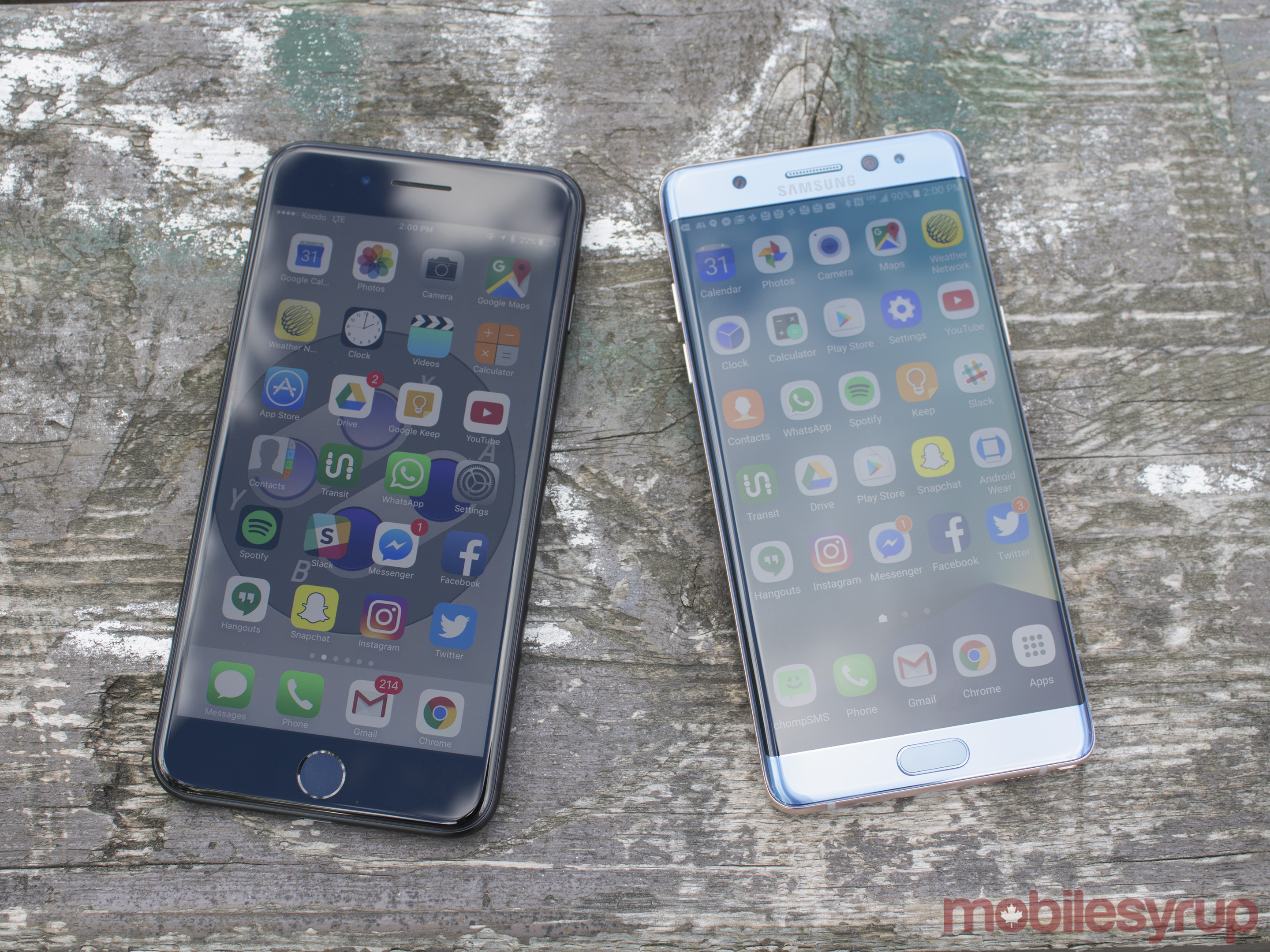 Unfortunately for Apple, despite the company’s best efforts, the fact that the phone still adopts the same form factor it’s clung to since the 6, results in it looking slightly dated when sitting beside the Note 7 and to a lesser extent, even the S7 and S7 Edge.
Unfortunately for Apple, despite the company’s best efforts, the fact that the phone still adopts the same form factor it’s clung to since the 6, results in it looking slightly dated when sitting beside the Note 7 and to a lesser extent, even the S7 and S7 Edge.
That’s not to say that the 7 doesn’t look sleek when compared to most other high-end handsets, but for me, Samsung has usurped Apple’s smartphone aesthetic crown by a small margin.
Under the hood
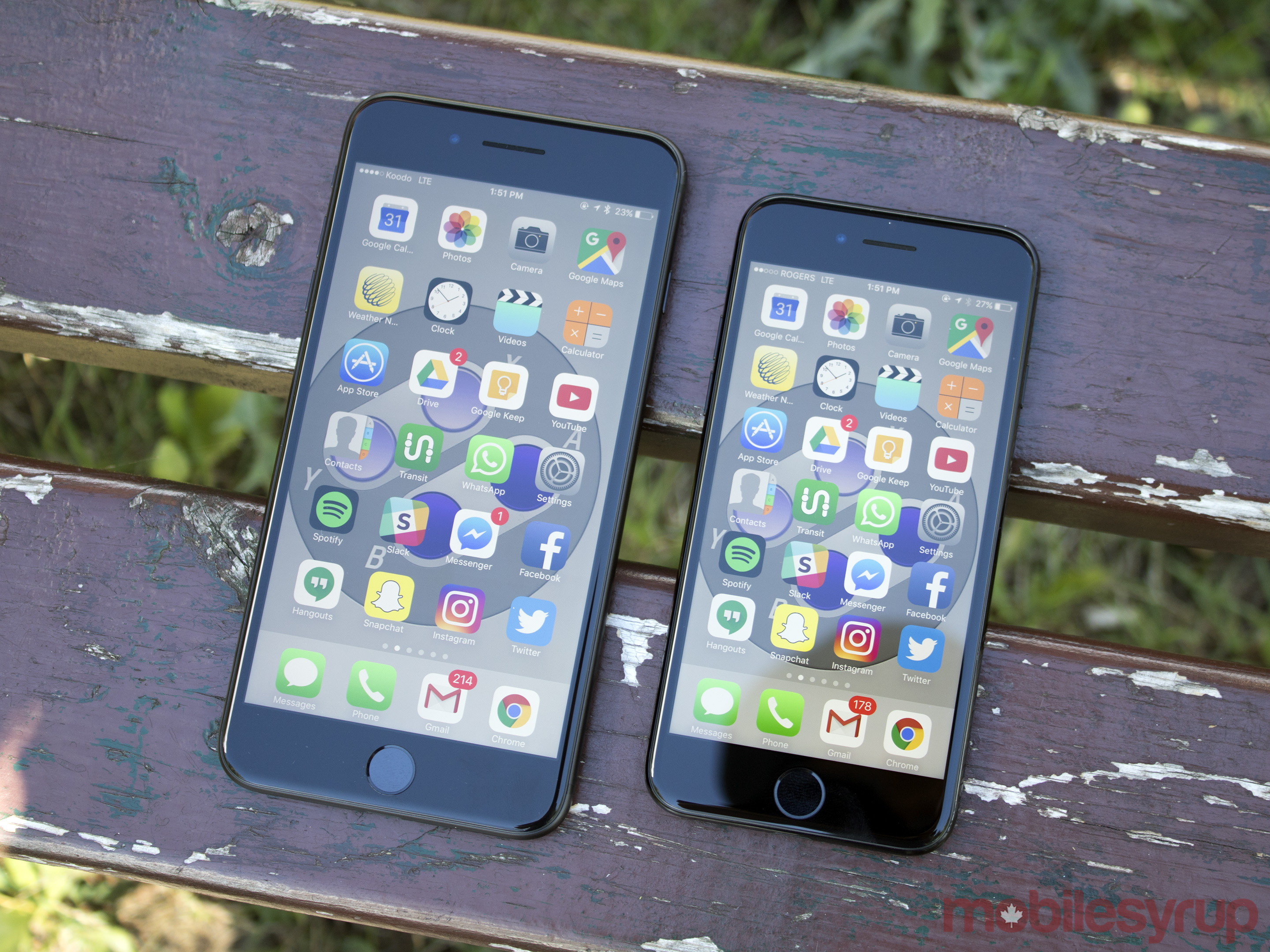 Moving to technical specs, the 7 and 7 Plus feature a variety upgrades over the 6s and 6s Plus, though it’s important to note that a number of key features haven’t changed.
Moving to technical specs, the 7 and 7 Plus feature a variety upgrades over the 6s and 6s Plus, though it’s important to note that a number of key features haven’t changed.
For example, the 7 Plus measures in at 158.2mm x 77.9mm x 7.3mm, with the iPhone 6s Plus coming in at 158.1mm x 77.8mm x 7.1mm, making it actually thicker than its predecessor. In comparison, the 6s measure in at 138.3mm x 67.1mm x 7.1mm, with the 7 also coming in at 138.3mm x 67.1mm x 7.1mm.
The 7 Plus’ 1080 x 1920 401ppi IPS LCD display measures in at 5.5-inches just like last year’s phone, though the phone is 30 percent brighter now according to Apple and features 625 nits over the 500 nits in 6s Plus.
The 7 Plus is also slightly lighter at 188g over the 192g 6s Plus. The 7 is in the same situation, coming in at 4.7-inches with a 750 x 1334 pixel IPS LCD display and 326ppi, just like the 6s, though does feature a 30 percent brighter display. It also weighs 138g compared to its predecessor’s 143g.
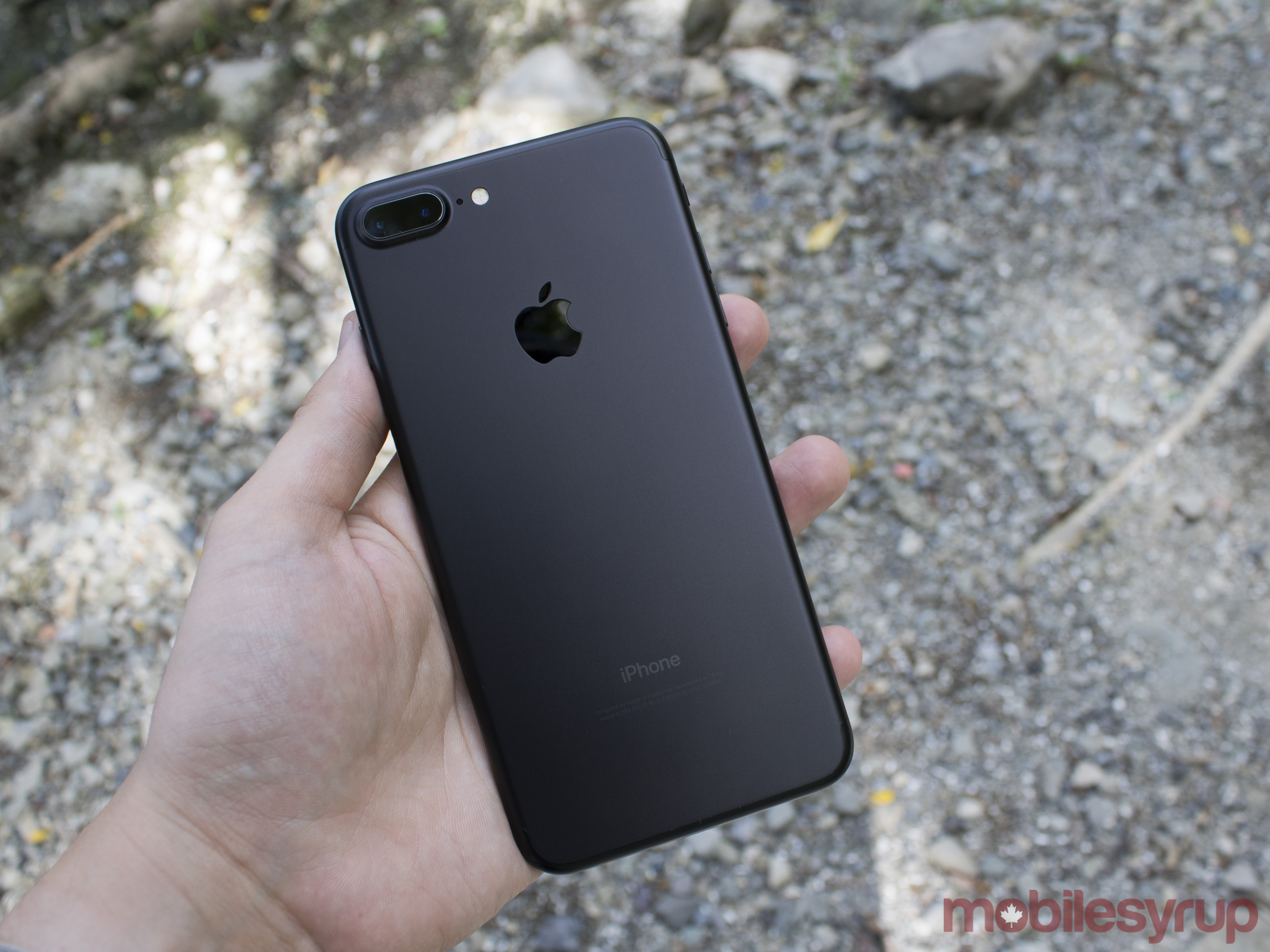 In my experience, the 7 and 7 Plus’ screens look great, but also nearly identical to last year’s devices. I buy Apple’s claim that the screen is brighter and more vibrant, but the difference is negligible. It would have been great to see the tech giant finally opt for a quad HD screen like many of its Android competitors, but for most purposes, the added resolution is not necessary.
In my experience, the 7 and 7 Plus’ screens look great, but also nearly identical to last year’s devices. I buy Apple’s claim that the screen is brighter and more vibrant, but the difference is negligible. It would have been great to see the tech giant finally opt for a quad HD screen like many of its Android competitors, but for most purposes, the added resolution is not necessary.
While the 7’s display and body dimensions remain nearly identical to the 6s, its processor has actually received a substantial upgrade. Apple says that its new A10 quad core Fusion processor is 40 percent faster than the 6s’ A9. While my time with the phone has been relatively limited, it handles high-end gaming, jumping between apps, and various intensive photography apps, with ease. Not once during my time with the iPhone 7 or 7 Plus have either phones lagged or slowed down.
The A10’s new quad core setup also has a stark division between its cores, with two being focused on high-end tasks like gaming, and then the remaining energy efficient pair of cores focused on everyday activities. While it’s difficult to know for sure, I think my smooth experienced with the phone, at least so far, is due to the Fusion chip’s new quad core setup. Apple also says that graphics performance has been improved by 50 percent over the A9 thank to its new silicon.
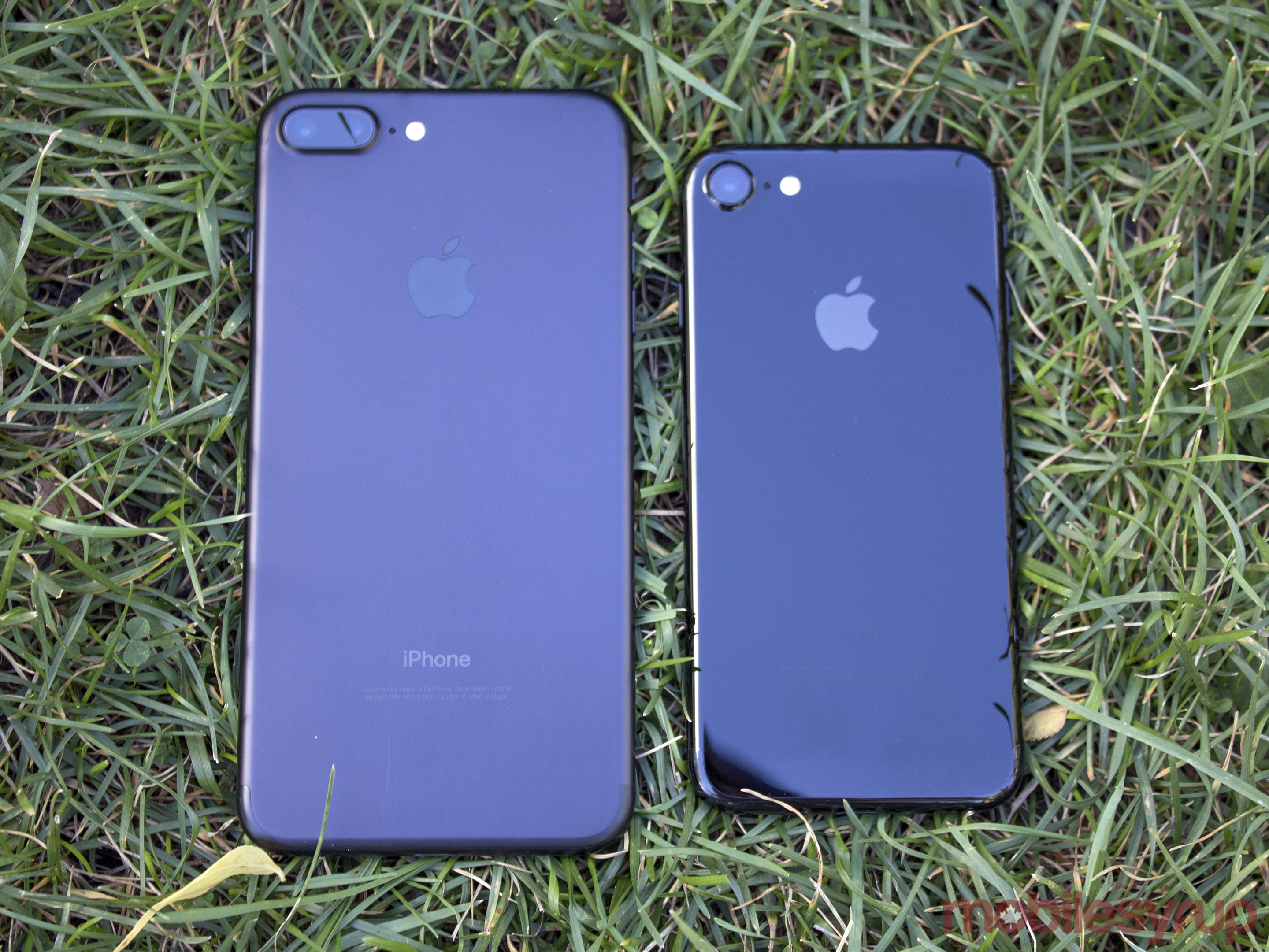 It’s also worth noting that the 7 features 2GB of RAM with the 7 Plus opting for 3GB (I ran benchmarks and doublechecked this spec). Coupled with the A10, the 7 Plus is benchmarking as one of the fastest smartphones on the market, exceeding even the 12.9-inch iPad Pro in terms of performance.
It’s also worth noting that the 7 features 2GB of RAM with the 7 Plus opting for 3GB (I ran benchmarks and doublechecked this spec). Coupled with the A10, the 7 Plus is benchmarking as one of the fastest smartphones on the market, exceeding even the 12.9-inch iPad Pro in terms of performance.
With all technical jargon aside, if you’re curious about the iPhone 7’s performance, rest assured — the phone is a beast.
Apple regains its camera dominance
The Note 7, S7 and S7 Edge, are the current kings of mobile photography, followed closely behind by Apple’s iPhone 6s and 6s Plus and a number of other smartphones. With the 7 and 7 Plus, Apple has successfully regained its camera throne, in part, due to the fact that the 7 now features image stabilization just like the 7 Plus, but also because of the 7 Plus’ new dual-camera setup.
We’ve seen dual-camera before in smartphones like the LG G5, upcoming LG V20 and the Leica-powered Huawei P9, which just like most of the Chinese company’s devices, isn’t coming to Canada. In the case of the 7 Plus, however, Apple has finally made the concept of a dual camera make sense.
Here’s how it works on a very basic level: the iPhone 7 Plus actually contains two cameras, a 27mm lens and a 56mm wide-angle shooter, with the former featuring optical 1x-zoom and the latter 2x-zoom. When shooting with the phone you can select between 1x or 2x optical zoom, and then all the way up to 10x digital.
Apple claims it has improved the clarity of photos that utilize digital zoom and while this is true, they still tend to be blurry and difficult to shoot. 2x optical shots, however, look spectacular. It may sound hard to believe, but 2x zoom actually makes a significant difference when shooting from a distance.
Overall image quality, whether you’re shooting with the iPhone 7 or 7 Plus, has been improved significantly thanks to both phones now featuring image stabilization — last year only the 6s Plus included IS — as well as a faster f/1.8 lens, allowing more light to hit the phone’s sensor. In comparison, the S7 features an f/1.7 lens.
The rear camera rocks a 12-megapixel shooter, the same amount of pixels as last year, with the front-facing camera being bumped up considerably, from a measly 5 megapixels in the 6s series, to 7, resulting in significantly better selfies.
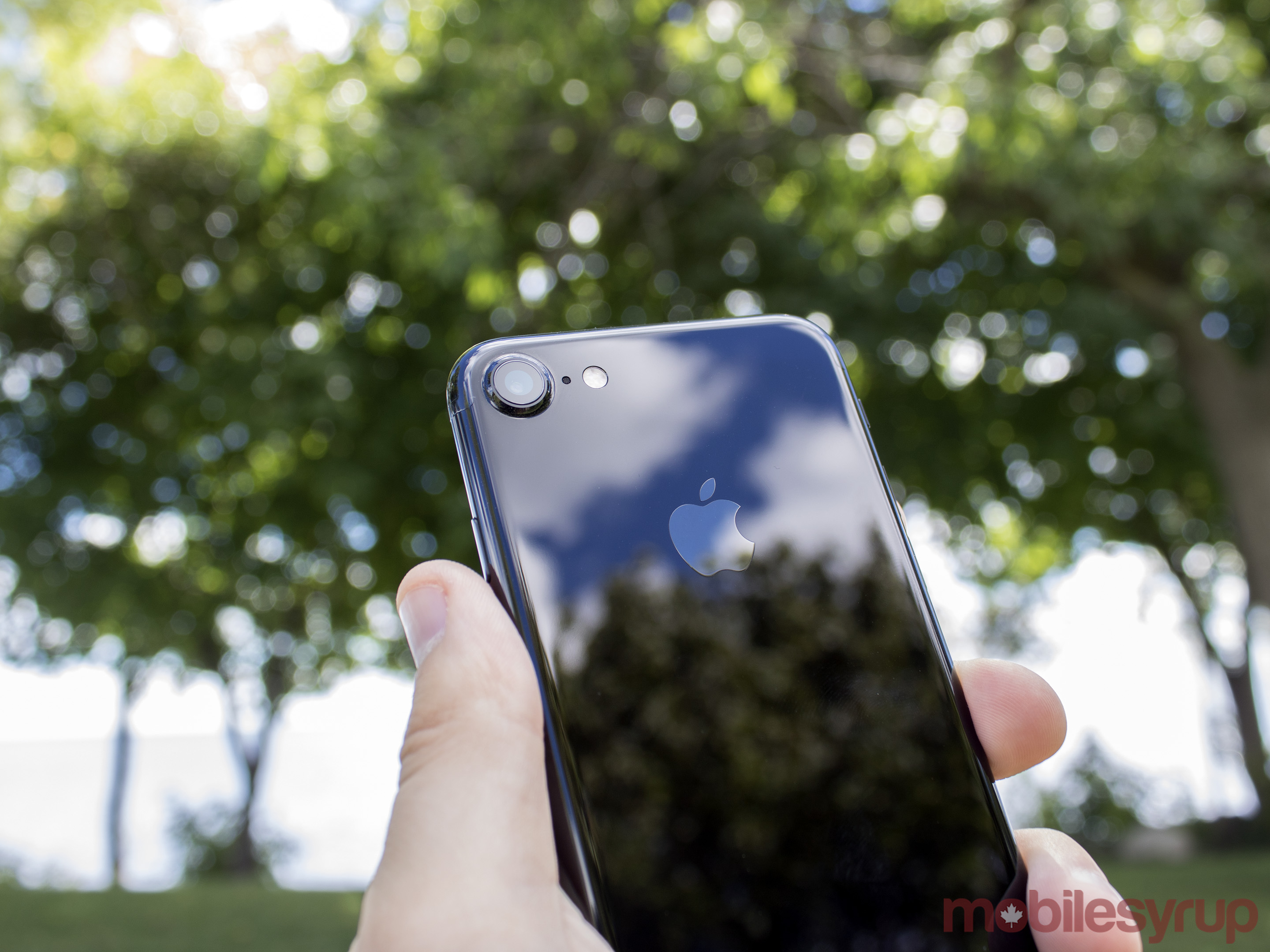 A new image signal processor (ISP) that’s part of Apple’s new A10 chip, a Quad-LED True Tone Flash and new Wide Colour Capture, round out the experience. In practice, I found both the 7 and 7 Plus’ camera performance to be spectacular, with the handsets snapping vibrant, colourful photographs under almost any conditions, including extremely low light and notably even with the selfie shooter.
A new image signal processor (ISP) that’s part of Apple’s new A10 chip, a Quad-LED True Tone Flash and new Wide Colour Capture, round out the experience. In practice, I found both the 7 and 7 Plus’ camera performance to be spectacular, with the handsets snapping vibrant, colourful photographs under almost any conditions, including extremely low light and notably even with the selfie shooter.
Unfortunately, the impressive depth-of-field iPhone 7 Plus feature the company showed off during its keynote is not yet available, though it’s coming in an update next month. It’s a shame this feature isn’t ready for launch because it could be a game changer, especially for those, like myself, who are tired of lugging their DSLR around all the time — get ready for ‘Bokeh.’
iOS 10’s Today View is spectacularly useful
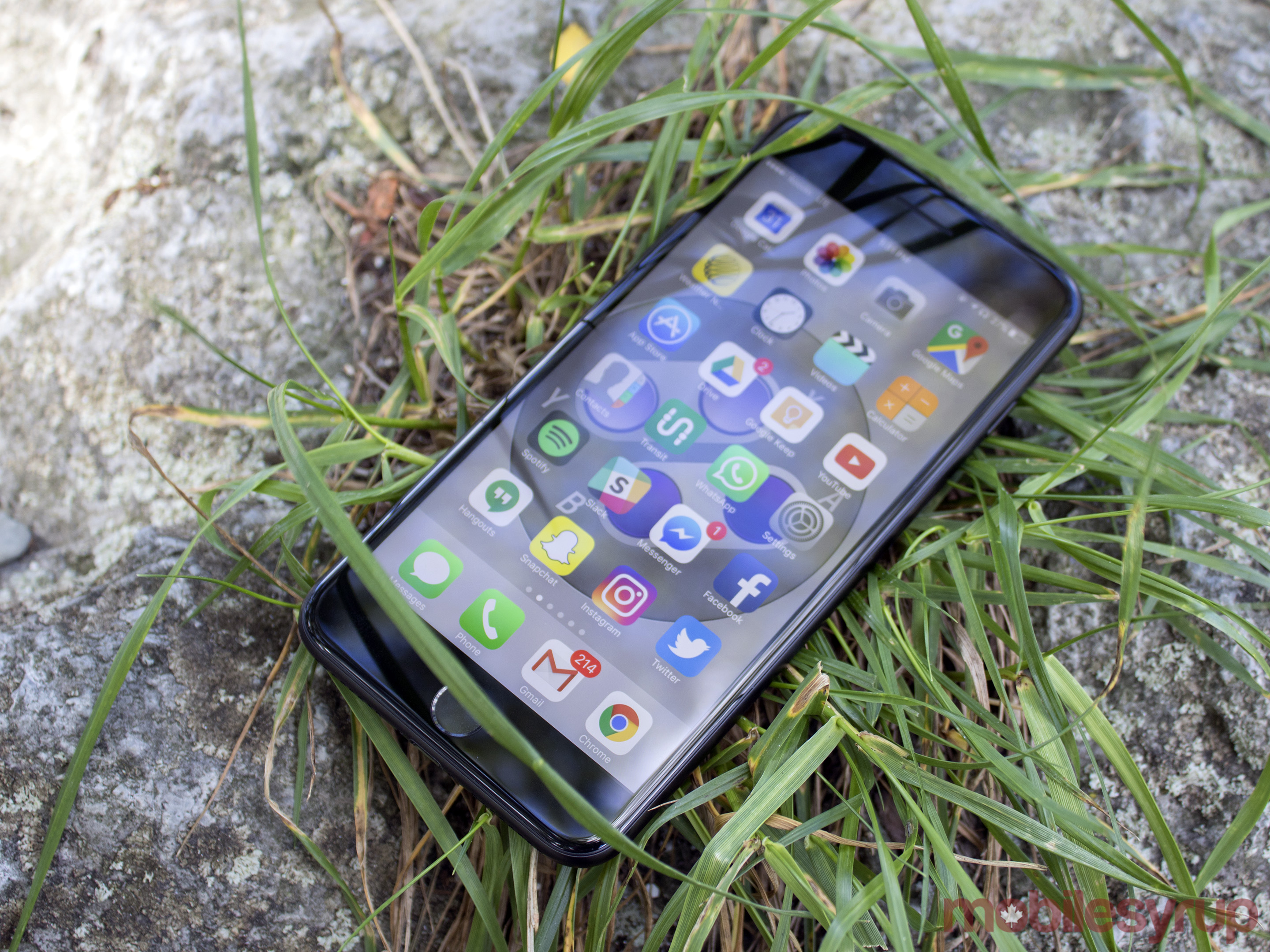 On September 13th, iOS 10 drops on the every iPhone 5 and up, bringing a number of new features to the device. We’ve covered iOS 10 considerably a few weeks ago when the beta first launched and my thoughts about the operating system generally echo my view on the iPhone 7.
On September 13th, iOS 10 drops on the every iPhone 5 and up, bringing a number of new features to the device. We’ve covered iOS 10 considerably a few weeks ago when the beta first launched and my thoughts about the operating system generally echo my view on the iPhone 7.
New features like Today View, which gives a brief overview of various widgets like Transit App, Weather and Calender, raise to wake, the ability to slide into the camera option and a revamped, significantly more useful Control Centre, are great. It’s worth noting that none of iOS 10’s new features are particularly mind blowing and that new third-party Siri voice integration remains somewhat sparse.
Also, as an avid photographer, it’s great that RAW support is coming to third-party photography apps, though only the 6s, 6s Plus and SE will be able to utilize the new feature. Unfortunately, I wasn’t able to test out iOS 10’s new RAW support because no camera apps have released updates to support the file format.
An iterative future
 Whether or not the iPhone 7 is for you will depend on your expectations and which current iOS device you’re using. If you’re still rocking a 6 or 5, the 40 percent increase in hardware power over the 6s with with the iPhone 7, could be reason alone to warrant an upgrade. Subtle new features like the home button’s new Taptic Engine and Stereo speakers, breathe new life into the aging overall design.
Whether or not the iPhone 7 is for you will depend on your expectations and which current iOS device you’re using. If you’re still rocking a 6 or 5, the 40 percent increase in hardware power over the 6s with with the iPhone 7, could be reason alone to warrant an upgrade. Subtle new features like the home button’s new Taptic Engine and Stereo speakers, breathe new life into the aging overall design.
Still, it’s hard hard not to wonder what Apple has in store for the iPhone 8 given the 7’s incremental step forward.
Those hoping for a complete overhaul, which is still reportedly coming in the iPhone 8, will likely be disappointed with Apple’s ‘if it isn’t broken, don’t fix it’ approach with the iPhone 7 and 7 Plus.
The iPhone 7 is available in 32GB for $899, 128GB at $1,049 and 256GB at $1,159, and the iPhone 7 Plus is priced at $1,049 for the 32GB model, $1,179 for 128GB and finally, $1,309 for the 256GB iteration.
Pros
- Sleek new colour options (Jet black and Black)
- One of the most powerful smartphones on the market
- Taptic Engine is great
- Waterproof
- Camera is incredible, especially in the 7 Plus
Cons
- No headphone jack (for some, this is a dealbreaker)
- An iterative update
- Screen resolution has not been improved
- Jet Black is a fingerprint magnet
Related: iPhone 7 and 7 Plus hands-on: Death of the headphone jack
MobileSyrup may earn a commission from purchases made via our links, which helps fund the journalism we provide free on our website. These links do not influence our editorial content. Support us here.


